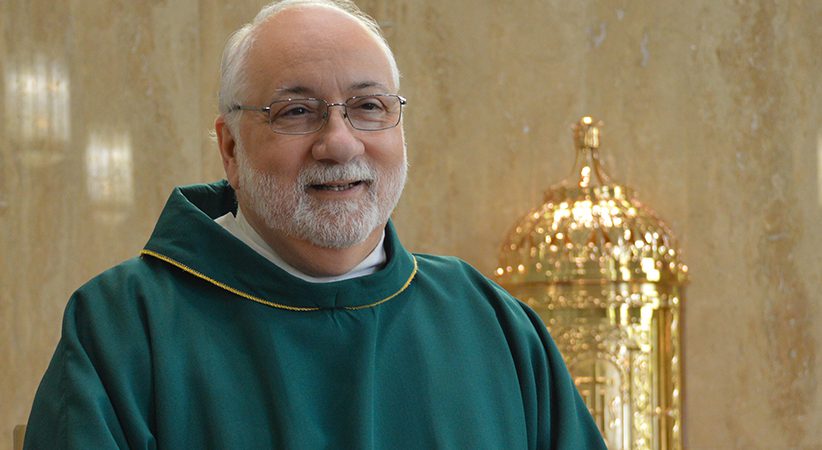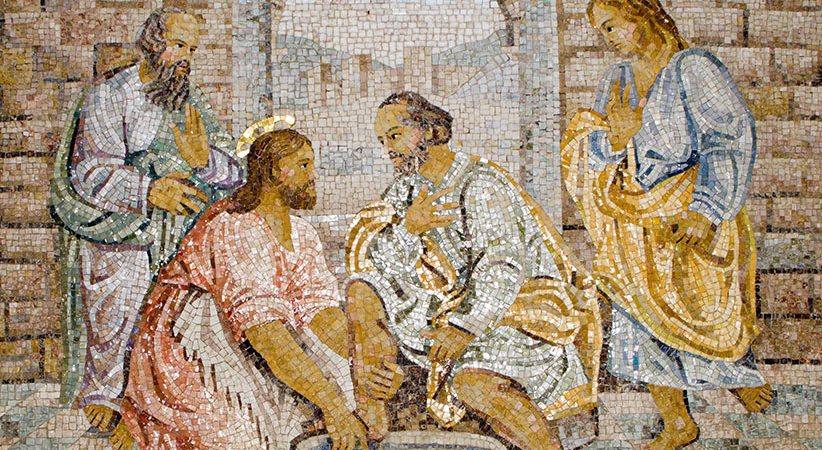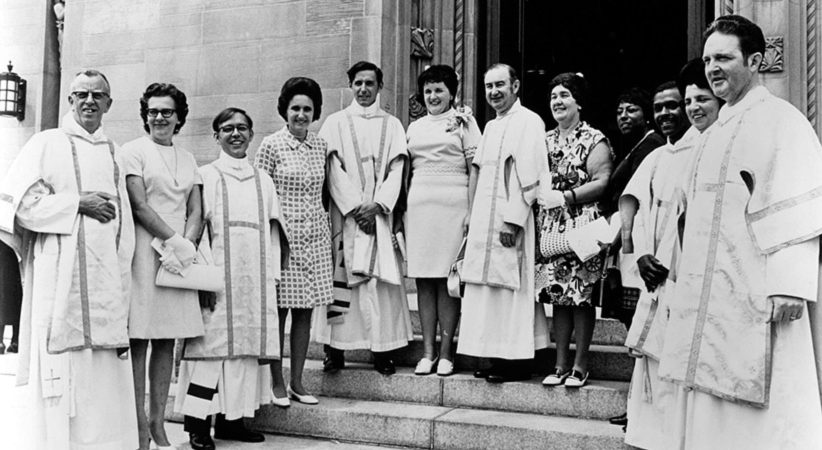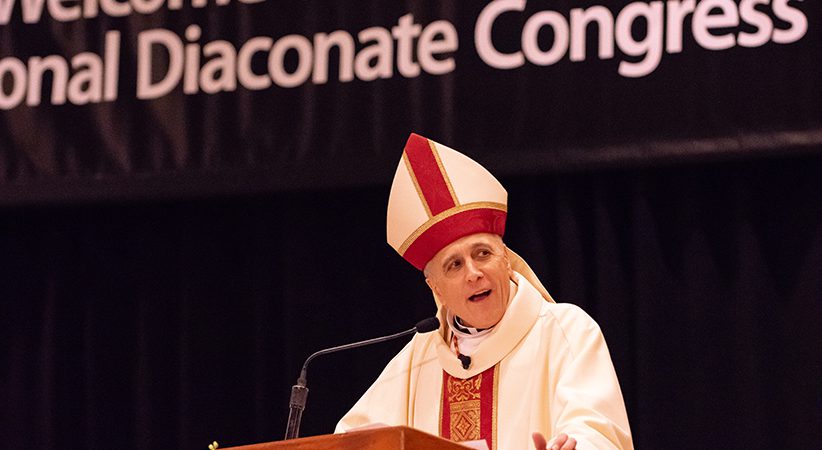Preach with Living Water
Guidelines for preaching at the Order of Baptism for Children
Dr. Susan Fleming McGurgan Comments Off on Preach with Living Water
The recent translation of the Order of Baptism of Children hands preachers an excellent incentive to sharpen their skills for baptismal preaching. Sacramental and liturgical encounters with Christ lie at the heart of our experience as Catholic Christians, and our celebrations not only form our understanding of faith and community but reveal the presence of God in our lives.
The entrance of a child into a family is a powerful event. It is universal yet intensely personal. It roots us in the past, transforms our present, and launches us into the future. It paradoxically expands our horizons while focusing our gaze. It is joyful, generative and humbling, a particular moment of grace and opportunity when the Gospel can come alive.
When we meet at the font, we gather as people both broken and blessed. Drawn by faith, love, obligation or simple proximity, the assembly will include doubters and believers, skeptics and seekers, the faithful and the fearful. Those who rest in the assurance of God’s love stand shoulder to shoulder with those whose relationship with God, the Church or their own family may be tenuous, fractured or littered with landmines. Regardless of our situation, we long for words of blessing and possibility, and the assurance that our lives have meaning and purpose.
The rite of baptism opens a remarkable window onto this fertile landscape and offers the Church an opportunity to engage, invite and respond. It places the parish on a journey with people whose season of life makes them remarkably open to hearing a word of hope. The baptism of a child can inspire parents, godparents and family members to examine their faith and their need for a supportive community. At the same time it can motivate the parish to embrace the vital work of evangelization, hospitality and mission.
The preacher is in a unique position to address this situation. He “represents this community by voicing its concerns, by naming its demons, and thus enabling it to gain some understanding and control of the evil which afflicts it. He represents the Lord by offering the community another word, a word of healing and pardon, of acceptance and love” (Fulfilled in Your Hearing, No. 13; USCCB Publishing). Baptismal preaching allows deacons to re-propose and re-articulate faith for those who believe, offer an invitation to those who don’t and reassure those who struggle that God binds up wounds and sets captives free. In this work, the deacon serves as both bridge-builder and mystagogue. As bridge-builder, he connects the community, the Church and the saving action of Christ. As mystagogue, he invites the community to reflect deeply on the mystery of that encounter.
Baptismal preaching also presents significant challenges: an ever-changing assembly that includes visitors of various backgrounds and degrees of faith, unpredictable and often disruptive infants and toddlers, distracted adults, awkward physical settings and limited time. Given the brevity of baptismal preaching, no single homily can or should include everything that could be said or employ more than one focus, approach or theme, but these general principles can provide a structure to preach the Good News of Christian initiation.
Preach Christ
W.C. Fields famously quipped, “Never work with animals or children.” His caveat reminds us that children are both capricious and charming, capable of upstaging even the most accomplished orator. It is tempting to preach about the babies and toddlers in our midst, but it is Christ who invites us to get wet! We celebrate with the baptized and embrace their presence as signs of our redemption, but the subject of baptismal preaching is always Christ.
Preach Verbally
Sacraments are living encounters with the Triune God, and baptism abides in the world of verbs. Baptism is initiating, anointing, worshipping, drowning, thirsting, igniting, blessing, welcoming, immersing, dying, rising and sending forth. Preach in an active voice, making ample use of the present tense. Allow dynamic verbs to illuminate the dynamic actions of Christ in the community.
Preach the Kerygma
Many Catholics, including some who regularly attend church, cannot articulate the fundamental message of Christ. Redemptoris Missio (Pope St. John Paul II’s encyclical on the permanent validity of the Church’s missionary mandate) reminds us that the kerygma is the Good News that changes history, news that “all peoples have a right to hear” (No. 44). This Gospel-in-a-nutshell proclamation of Christ crucified, died and risen fueled the spread of Christianity from a remote outpost of the Roman empire and continues to transform the world today.
Preach Vocation
Baptism calls us by name, anoints us as priest, prophet and king, and sends us out as disciples. Whether that journey leads to marriage and the domestic church, chaste singleness, religious life or ordination, baptism orients our lives toward mission. Help the assembly embrace the dignity of God’s call and envision the limitless potential of the newly baptized.
Preach Mystagogically
Mystagogical preaching taps into the power of beauty, imagination and symbol to illuminate the truth that lies just beyond our words. Our culture is ritually impoverished and mystagogical preaching moves listeners to a deeper understanding of the mystery just celebrated by asking, “What did we experience? What does it mean?” It engages the senses and weaves the language, images and sensory experiences of the liturgy and season into the lives of the listeners. Preparation for mystagogical preaching is rooted in prayer and reflection and leads outward to enlighten and deepen the faith of the listeners.
Preach Ecclesially and Communally
Our practice of baptizing outside of Mass in private ceremonies and celebrating baptism, first Eucharist and confirmation as distinct rites separated by years can lead to a view of baptism as isolated and individual, rather than interconnected and communal. Baptism and preaching are ecclesial acts rooted in the ministry of Jesus, the Communion of Saints and the experience of the entire Church. Invite listeners to see the larger picture and reflect on the ways that ritual moments connect us.
Preach with Living Water
It is tempting, given the brevity of the baptismal homily and the intimacy of the setting, to offer extemporaneous remarks. Resist this temptation. The most casual listener can discern between powerful and evocative words, chosen for a particular place, and off-the-cuff comments that neither connect or inspire.

It is also tempting to preach from a standard script. However, even if people believe your words are freshly drawn just for them, you cannot fool yourself. Preaching is formative — for the listener, certainly, but also for the preacher. Preaching from a template or failing to prepare at all is an easy road when effective preaching always demands the harder path. Preparing for each liturgy requires you to take risks, to try new approaches, to view the rite through a different lens, to consider who is gathering at the font and to engage in ongoing reflection on the mystery of our encounters with Christ. The people of God are thirsting for life-giving words from preachers who know where to find the deep wells.
Before Jesus healed the first leper or a single parable was told; before the crowds began to gather or the palm branches cut; before Jesus called a single disciple, he went into the Jordan to be baptized. At that moment, God tore open the heavens, sent down the Holy Spirit, and declared, “This is my beloved Son, with whom I am well pleased” (Mt 3:17). God’s love was present at the beginning of the journey, long before the ending was revealed. God’s love surrounded Jesus before he calmed the storm or set one captive free. God’s love sustained Jesus, not because Jesus earned something, or proved something, but because he was something.
We too are called to the water. Baptismal preaching is the opportunity to share the Good News that heaven has been opened for us, that God’s love is our birthright, present at the beginning of our journey, long before the ending is revealed.
We are invited to shake the water from our eyes and proclaim that Christ is with us, not because we earned something or proved something but because we are something. In baptism, we dare to look upon a child dripping with water and glistening with oil and say to each other, “This child will never die.” These are moments worth preaching well.
DR. SUSAN FLEMING McGURGAN is Director of Lay Ecclesial Formation and Associate Professor of Pastoral Theology for The Athenaeum of Ohio/Mount St. Mary’s Seminary. She teaches Homiletics II for Permanent Deacons and will be the Marten Visiting Fellow in Preaching at the University of Notre Dame during the fall semester 2020.
……………………………………………………………………………………………………………………………………………………………
Baptismal Resources
“Preaching for Discipleship: Preparing Homilies for Christian Initiation” (Liturgy Training Publications, $21.95), by Michael E. Connors, CSC, is an excellent resource for priests, deacons and catechists who work with the Rite of Christian Initiation of Adults.
“Fulfilled in Your Hearing: The Homily in the Sunday Assembly” (USCCB Publishing, $22.10)
“Ambrose of Milan’s Method of Mystagogical Preaching” (Liturgical Press, $34.95), by Craig Alan Satterlee, articulates a modern method of mystagogical preaching by examining the sermons of Ambrose of Milan. It provides valuable background into the history and meaning of mystagogy and offers practical applications for preaching today.
…………………………………………………………………………………………………………………………………………………………….





